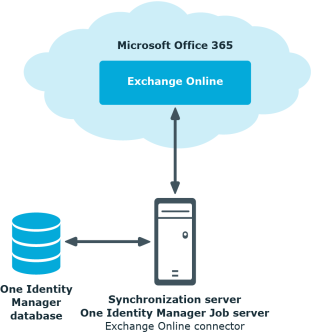Managing Exchange Online environments
The key aspects of administrating an Exchange Online system with One Identity Manager are local mapping of mailboxes, email users, email contacts, mail-enabled distribution groups, and Office 365 groups from a cloud environment.
The system information for the Exchange Online structure is loaded into the One Identity Manager database during data synchronization. It is only possible to customize certain system information in One Identity Manager due to the complex dependencies and far reaching effects of changes.
For more detailed information about the Exchange Online structure, see the Exchange Online documentation from Microsoft.
Related topics
Architecture overview
To access Exchange Online organizational data, the Exchange Online connector is installed on a synchronization server. The synchronization server ensures data is compared between the One Identity Manager database and Exchange Online. The Exchange Online connector is part of the Exchange Online Module and responsible for communicating with the Microsoft Office 365 subscriptions of Exchange Online in the cloud. Windows PowerShell is used to access the Exchange Online data.
To access the data in an Exchange Online organization, the Azure Active Directory target system containing the organization must be synchronized.
Figure 1: Architecture for synchronization

One Identity Manager users for managing Exchange Online
The following users are used for setting up and administration of Exchange Online.
Table 1: Users
| Target system administrators |
Target system administrators must be assigned to the Target systems | Administrators application role.
Users with this application role:
-
Administer application roles for individual target system types.
-
Specify the target system manager.
-
Set up other application roles for target system managers if required.
-
Specify which application roles for target system managers are mutually exclusive.
-
Authorize other employees to be target system administrators.
-
Do not assume any administrative tasks within the target system. |
| Target system managers |
Target system managers must be assigned to the Target systems | Exchange Online application role or a child application role.
Users with this application role:
-
Assume administrative tasks for the target system.
-
Create, change, or delete target system objects like user accounts or groups.
-
Edit password policies for the target system.
-
Prepare groups to add to the IT Shop.
-
Can add employees who have an other identity than the Primary identity.
-
Configure synchronization in the Synchronization Editor and define the mapping for comparing target systems and One Identity Manager.
-
Edit the synchronization's target system types and outstanding objects.
-
Authorize other employees within their area of responsibility as target system managers and create child application roles if required. |
| One Identity Manager administrators |
-
Create customized permissions groups for application roles for role-based login to administration tools in the Designer as required.
-
Create system users and permissions groups for non role-based login to administration tools in the Designer as required.
-
Enable or disable additional configuration parameters in the Designer as required.
-
Create custom processes in the Designer as required.
-
Create and configure schedules as required.
-
Create and configure password policies as required. |
Setting up Exchange Online synchronization
One Identity Manager supports synchronization with Exchange Online.
One Identity Manager is responsible for synchronizing data between the Exchange Online database and the One Identity Manager Service. Synchronization prerequisites are:
- Synchronization of the Azure Active Directory system is carried out regularly.
- The Azure Active Directory tenant is declared in One Identity Manager.
To load Exchange Online objects into the One Identity Manager database for the first time
- Prepare a user account in the Azure Active Directory tenant with sufficient permissions for synchronization.
-
One Identity Manager parts for managing Exchange Online systems are available if the TargetSystem | AzureAD | ExchangeOnline configuration parameter is set.
- Other configuration parameters are installed when the module is installed. Check the configuration parameters and modify them as necessary to suit your requirements.
- Install and configure a synchronization server and declare the server as a Job server in One Identity Manager.
- Create a synchronization project with the Synchronization Editor.
Detailed information about this topic

